Samsung Galaxy S 4 Review - Part 1
by Brian Klug on April 24, 2013 12:01 AM ESTDisplay
We wrote about how we suspected that SGS4 would go to a 5-inch 1080p SAMOLED display just after CES. Turns out that was spot on, as the SGS4 includes a 5-inch 1080p Full HD SAMOLED panel, the latest in Samsung's AMOLED roadmap. Samsung's naming stays true, and there's no Plus tacked on at the end, so we get another non-RGB stripe subpixel geometry with SGS4. The last few Samsung AMOLED variants we've seen have had different subpixel grids, and the one on the SGS4 is possibly the most interesting to date. There's still a bias toward more green subpixels than blue or red, this isn't an RGB stripe at all, but instead of the previous RG,BG layout we see this offset pattern with green on one line, then blue and red on another line. Interestingly enough the blue subpixel appears to be a square, and red and green appear to be circles, with the difference in area possibly offsetting the luminous efficiency of each material. Whatever the reason (Samsung has never been official or forthcoming any of these subpixel patterns each time they've changed them) it's present on the SGS4.
At this size however I have to admit that I find the pursuit of the subpixel geometry more of an educational one than something which affects users. While I could occasionally see it on the SGS3, I definitely do not see it on SGS4. The subpixels are now small enough that whatever the pattern, it all looks like a homogenous light-emitting surface, which was the goal after all. I could bring up the visual acuity discussion again but just trust me that it's small enough to not be visible even with actually perfect (not legally perfect, which is different) vision.
So resolution is great and up to par with all the other LCD-bearing flagships this year, lack of RGB stripe notwithstanding. There's that remaining question about brightness, contrast, outdoor visibility, and of course calibration and the saturation issue that has persisted with AMOLED from generation to generation.
On the brightness front, the SGS4 includes dynamic contrast functions that cannot be disabled and change as a function of what is being displayed. There's an "auto adjust screen tone" checkbox under display but don't let that fool you, that doesn't disable dynamic contrast, just white point. Under screen mode are the mDNIe toggles we've seen on countless other previous Samsung Android phones with AMOLED panels, only here we notice something interesting. There have always been four toggles as long as this option has existed, only what's different is now, one of them is named "Professional photo." Reviews of other regional variants of the SGS4 have included the same button but marked "Adobe RGB." Oddly enough it seems that the North American versions at least have this renamed for some reason, but undoubtedly the function is the same. Many speculated that this is now a toggle for some full CMS (Color Management System) which "fixes" the inherent color space issues with AMOLED and oversaturation that occurs when looking at sRGB content on such devices. Unfortunately, I can confirm that my initial suspicions that this is just a continuation of the mDNIe (lite) settings from previous generation is in fact correct. I reverse engineered what I could of these settings from both kernel messages while changing the toggles, and looking at the kernel sources. Turns out that 'Professional photo' mode is actually the 'Natural' mode renamed from previous versions.
So the question was whether the color space or white point actually does change with this mode enabled. I ran the SGS4 through our display tests in each of the modes and think the full color space plot tells the story. The sanest of them all really ends up being the strangely-named 'Movie' mode. Professional photo gives the big gamut with a white point closer to 'Movie,' which is to say around 7000K, but it doesn't fundamentally change the still-present oversaturation or color management issue that exists in Android with these wide gamut displays. Most users admittedly don't care however and just see "bright" colors. Theres' an Auto mode as well which the device ships with that basically has a matrix of mDNIe settings for targeted applications (for example the Gallery, Browser, Video playback) and so forth get settings, which you can see in the kernel.
| CalMAN Display Comparison | ||||||||||||
| Metric | iPhone 5 | iPhone 4S | HTC One X | SGS3 | Samsung Galaxy Note 2 | Google Nexus 4 | HTC Droid DNA | HTC One | SGS4 | |||
| Grayscale 200nits Avg dE2000 | 3.564 | 6.162 | 6.609 | 4.578 | 5.867 | 7.686 | 6.738 | 5.391 | 7.511 | |||
| CCT Avg (K) | 6925 | 7171 | 5944 | 6809 | 7109 | 8506 | 8108 | 8118 | 7020 | |||
| Saturation Sweep Avg dE2000 | 3.591 | 8.787 | 5.066 | 5.460 | 7.986 | 8.517 | 5.856 | 3.365 | 7.823 | |||
| GMB ColorChecker Avg dE2000 | 4.747 | 6.328 | 6.963 | 7.322 | 8.185 | 7.531 | 6.687 | 4.656 | 7.440 | |||
In the "Movie" mode things are better controlled than the Note 2 on the GMB color checker card test, which is the most important one for me. White point is also no longer the crazy 8000K that we saw before, 7000K is commendable for Samsung at this point. Keep in mind that maximum brightness changes in each mode as well as we effectively clamp things, I measured a maximum of 319 nits in Dynamic mode, 311 nits in Movie mode, and 255 nits in Standard, for example.
Running the display at maximum brightness for too long will also get you into an overheating or thermal protection mode as well, which we've seen on countless other AMOLED variants. Most of the time I suspect users will run on Auto brightness however which keeps brightness down to a much lower level to save battery and prevent that from becoming a problem.
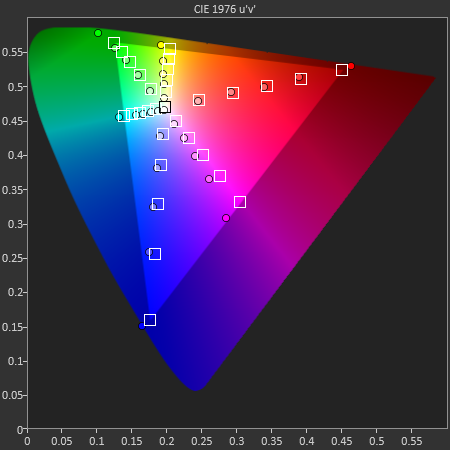
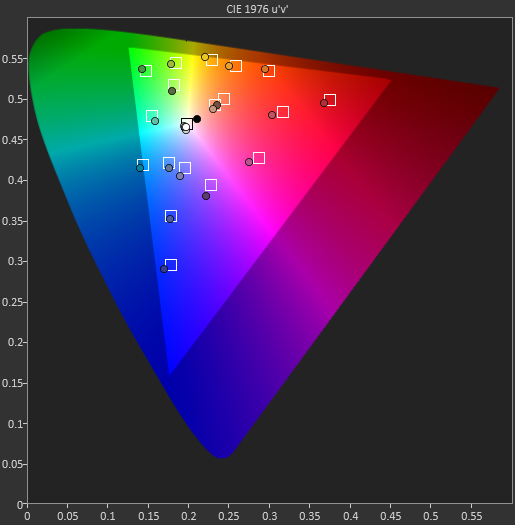
Because "Movie" was the closest to sRGB of all the modes, I selected it for the actual results that I'll present in the table. Admittedly this mode does tighten things up a bit, but it still isn't perfect and I'd still like to see Samsung do something to reign this in at some point.


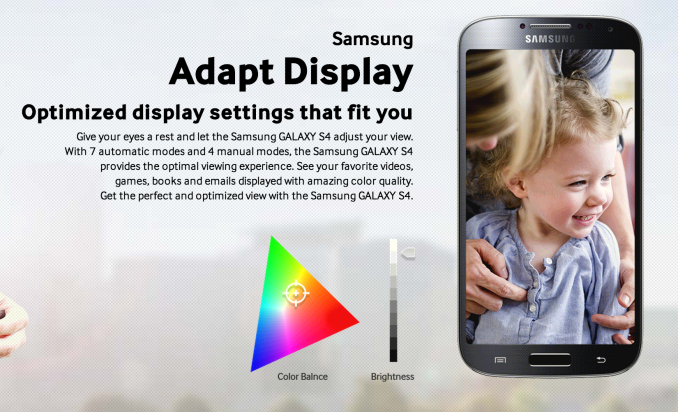




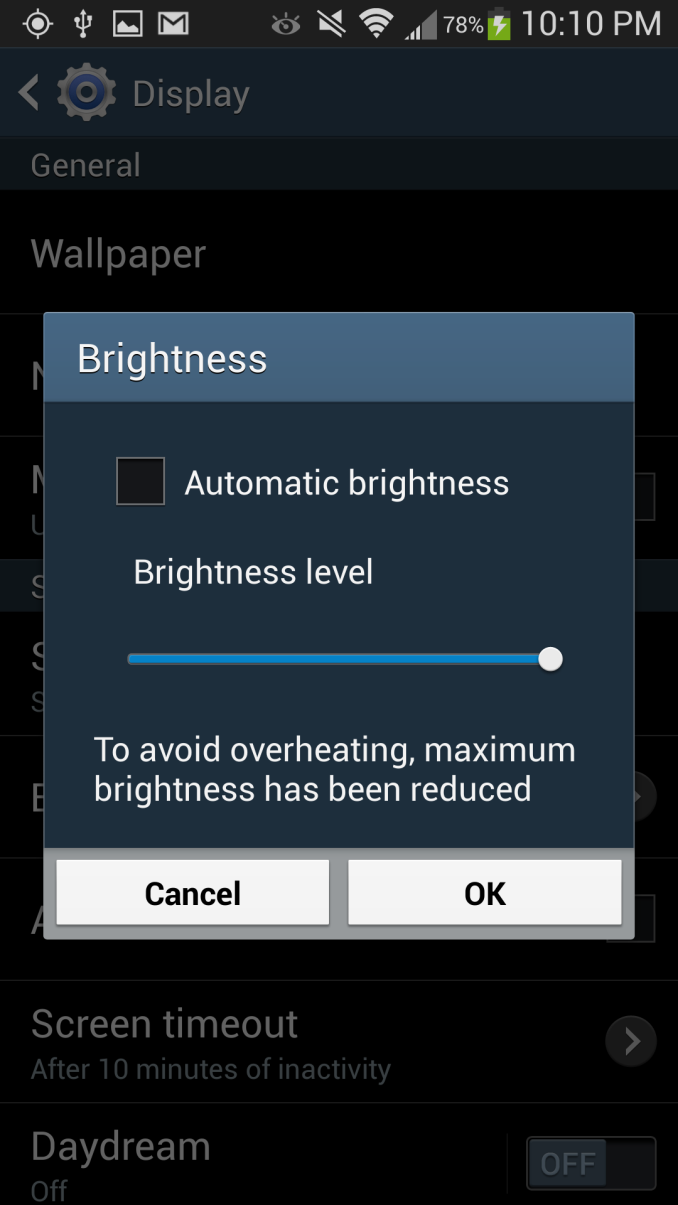
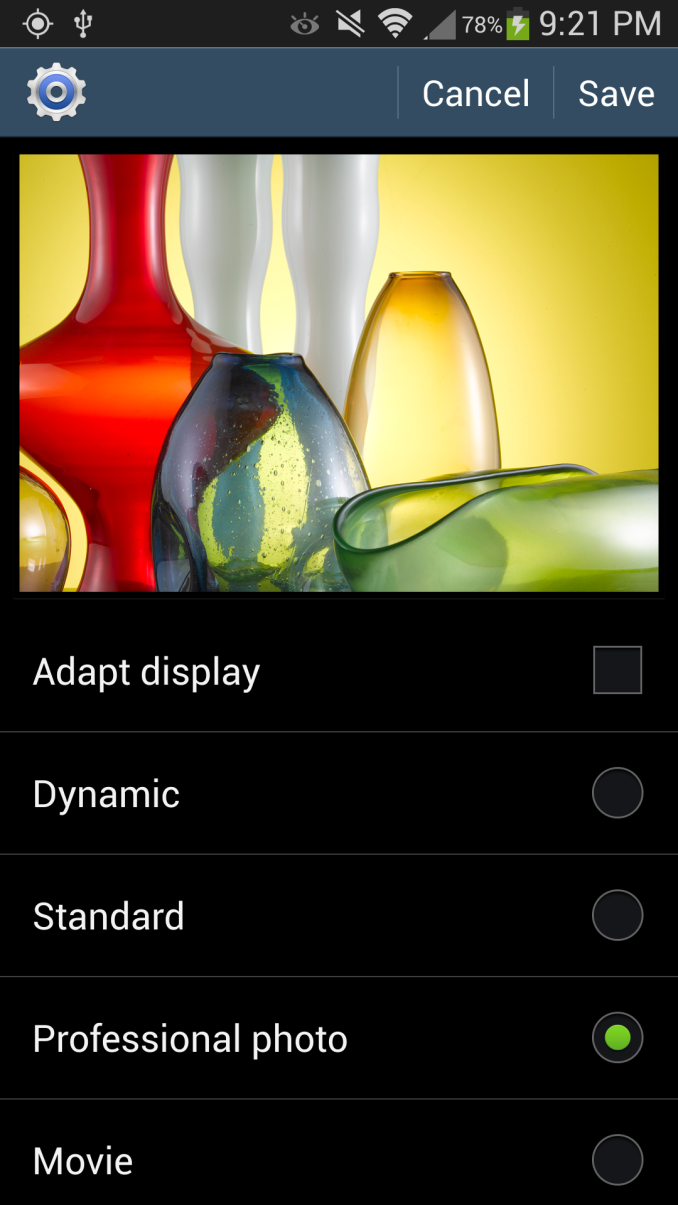
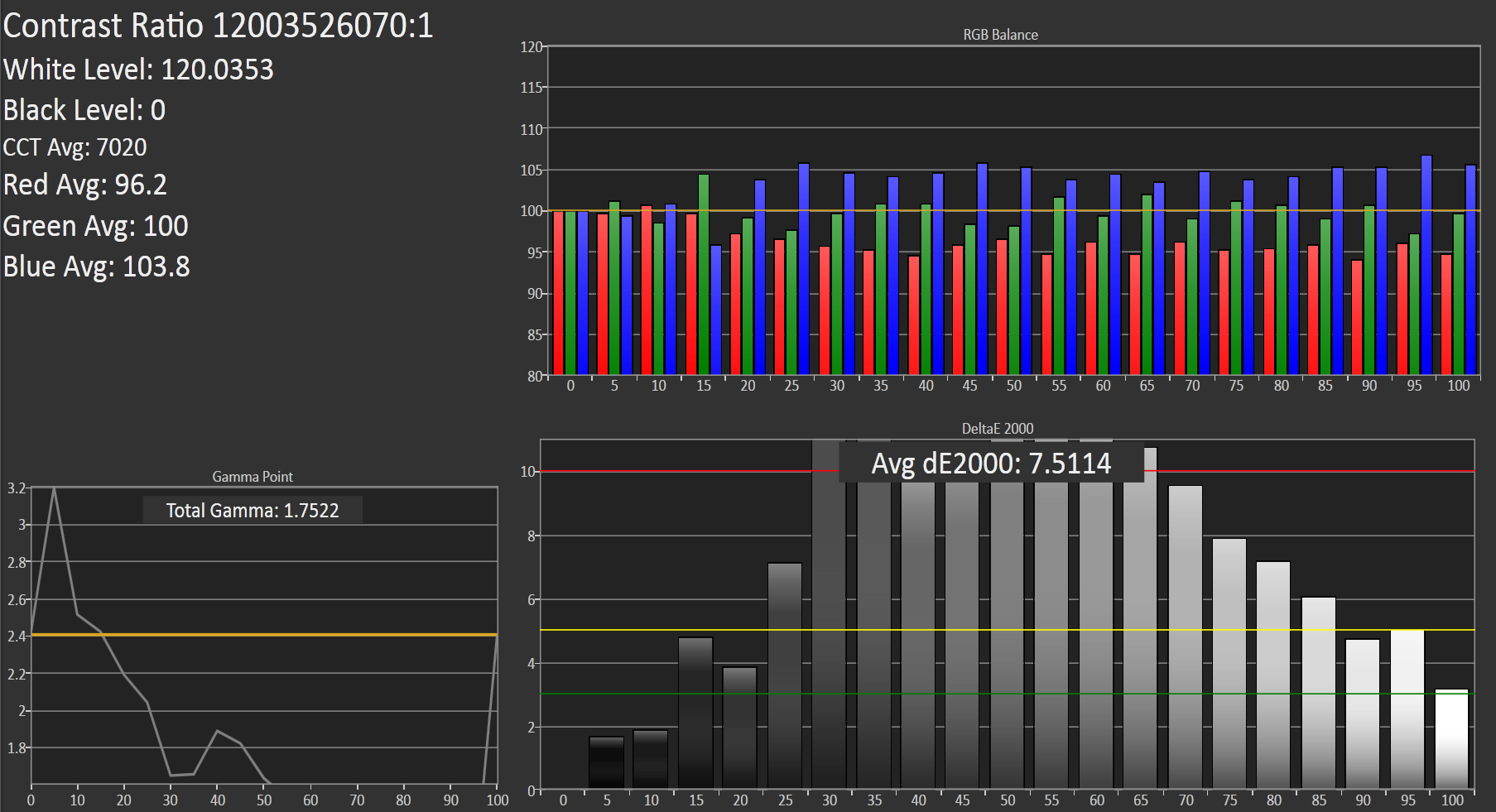








335 Comments
View All Comments
darwinosx - Wednesday, April 24, 2013 - link
Very few people have seen a Nexus phone or pure Android so its not correct to assume they prefer Touchwiz.nitenichiryu1 - Wednesday, April 24, 2013 - link
i agree! i actually prefer vanilla android to all the companies' versions of android.seamonkey79 - Wednesday, April 24, 2013 - link
Won't buy a phone without a removable battery. After two iPhone batteries and my friend's One X battery crapped out, it simply isn't worth it. Wouldn't mind a little bit better build from Samsung, but honestly my Note 2 is as good as my HTC Incredible was.Grandpa - Wednesday, April 24, 2013 - link
Wow. That's saying a lot. My old HTC Incredible had the most incredibly bad battery EVER. So bad I bought an iPhone with a terrific battery and lovin every minute of it.lilmoe - Wednesday, April 24, 2013 - link
let me guess, part 2 is for the Exynos GT-I9500 version.....berantle - Wednesday, April 24, 2013 - link
Thanks for the review. I'll be going with the HTC One. It is a better fit for me and my phone usage. I really like the HTC One's front stereo speakers. The S4 has too many new features/functions that I have little interest in using.The removable battery of the S4 is not important to me because even having had phones with a removable battery, I never felt a need to swap it out. Much better to recharge using a recharging battery pack - it's universal for charging other portable devices, plus the current packs can store 3-4x the energy that the batteries fitted in the phones can store.
Don't need removable SD card feature. Backed up my contacts/data to the cloud and to the PC. Do that regularly. I don't use my phone as a dumping ground for my music and movie files. Those go into my phone selectively and actively managed as to what I want in my phone storage.
The camera in the phones. I don't use them to replace my normal cameras. It's for the occasional shot and these skew to more indoors than outdoors. Thus, the HTC One's camera makes a better fit for me than the S4 camera. In my brief use of an HTC One, I tried the HTC One in a close macro shot and liked the results very much.
Aluminium or Polycarbonate? I have no problems with polycarbonate if it is nicely done like the recent Nokia phones and the HTC One X/Butterfly phones. The feel of the S3 was offputting and since the S4 is more of the same, then, no thanks. Holding the aluminium-cased HTC One, the big difference in feel makes me abhor the S3's feel even more, what more the S4 which is supposed to be the same.
rohini - Wednesday, April 24, 2013 - link
The SGS4 is surely a great smartphone but there are many other things which the buyers want from their smartphone. The aesthetics is the most important feature on the wish list of smartphone buyers. Samsung, you should know that people are now bored of your old plastic design. Why can't you come up with something made out of metal or glass or even sapphire?All Samsung has been doing for years is stuffing up its phones with the best in class hardware but forgot about what most of the persons like.
HTC One on the other hand is a an excellent example of innovation even though there are chances that it will fail to attract masses in the Indian market. http://goo.gl/VBNDG
nitenichiryu1 - Thursday, April 25, 2013 - link
Some have posted comments on how the S4 will have a locked bootloader (bummer), and that the HTC will be unlocked, but what about the recent article from engadget stating that it will change for the HTC, and most likely be locked. http://www.engadget.com/2013/04/15/htc-one-att-boo...teiglin - Thursday, April 25, 2013 - link
Skimming through the comments makes my head hurt. I wonder what percentage of idiotic commenters are marketers and what percent are legit fanboys. I hope they're mostly marketers; it's a bit scary to think that Samsung and HTC might have developed reality distortion fields that rival Apple's.Anyway, on the off chance you're still reading any of this garbage, Brian, I wanted to ask why you never do any reviews of custom ROMs/kernels. I realize this is a potential deathtrap of complication, so is it just that it's easier just to avoid even opening the door to it? I mean, the number of boneheaded manufacturer moves that can be fixed by some minor aftermarket tweaking is phenomenal: everything from silly button bindings (One) to janky design language (Touchwiz) to miserable screen calibration (Nexus 4) can be solved by spending 10-30 minutes on xda--and that's without even going into the less-stable areas or just-for-fun tweaks.
AndroidsFinest - Thursday, April 25, 2013 - link
I think I will wait to see what Google has to offer at Google I/O, if its just a revamped Nexus 4 than I might go for the HTC One. Samsung's plastic is getting a bit tiresome and off contract the 8 core international variant is extremely overpriced.